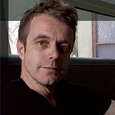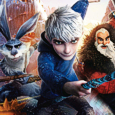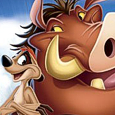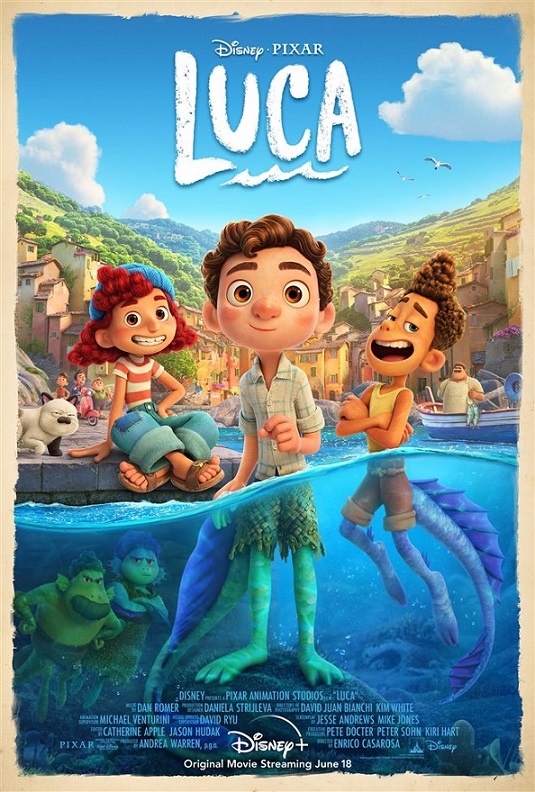 In Disney Pixar’s latest gem, Luca, the three main protagonists are planning to take part in a race called the “Portorosso Cup,” organized by a certain “Signora Marsigliese.” This is a nod, as Pixar likes to do them, to Character Art Director Deanna Marsigliese, who was revealed to wide audience in the Disney+ series Inside Pixar, in which she presented the wire sculptures that inspired the design of the Counselors, or “Jerries”, in Disney Pixar’s Soul – pure genius!
In Disney Pixar’s latest gem, Luca, the three main protagonists are planning to take part in a race called the “Portorosso Cup,” organized by a certain “Signora Marsigliese.” This is a nod, as Pixar likes to do them, to Character Art Director Deanna Marsigliese, who was revealed to wide audience in the Disney+ series Inside Pixar, in which she presented the wire sculptures that inspired the design of the Counselors, or “Jerries”, in Disney Pixar’s Soul – pure genius!
Deanna’s impressive journey at Pixar started actually in 2012, contributing designs to Academy Award©-winning films such as Inside Out, Toy Story 4, and Soul, as well as The Good Dinosaur, Finding Dory, Incredibles 2, and Onward.
Prior to Pixar, she studied Classical Animation at Sheridan College, as well as 3D Animation at Seneca College, both located in Toronto, Canada. She then freelanced as a 2D character animator and character designer on a wide variety of film, television and commercial projects. She has also served as the Professor of Classical Animation at Seneca College in Toronto for six years and continues to lead workshops worldwide.
On Luca, she acted as both Character Art Director and Animation Sketch Artist Lead, and her unique sensibility really shines throughout this immensely refreshing movie.
Here’s our conversation.

Animated Views: How did you meet Luca‘s Director, Enrico Casarosa and how did you start working on Luca?
Deanna Marsigliese: I met Enrico working on Luca. We’d spoken just once before, because I pursued him outside the gates of Pixar. I happened to see him leaving, I had heard that he was going to make this film set in Italy. I am a huge fan of (Casarosa’s) La Luna, I love that short, and I really badly wanted to be on this new film in any capacity. I wanted the Character Art Director position, but I would have just designed on it. Honestly, I just wanted to be part of the team. So, really, the first time I spoke to him was to tell him that I really had an interest in working on this project.
AV: And when you started as a Character Art Director on Luca, what was your first move?
DM: My first assignment, if you will, because our Production Designer Daniela Strijleva was the conductor of this orchestra, was to explore the sea monster characters. That was number one. Because for the Italian characters in Portorosso, we could find reference and historical photographs. But sea monsters, that’s a big unknown. There was a lot to explore. Being able to use your imagination like that is so wonderful, but it’s also a little overwhelming because where do you start? What do you use? What do you take?
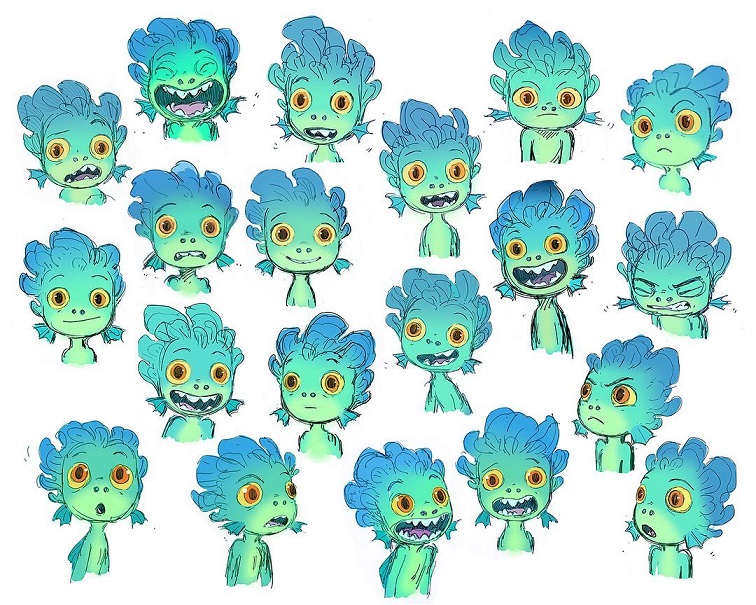
AV: So, from where did you draw your inspiration?
DM: I started very obviously by looking at “carte marine,” which are antique maps. I looked at a lot of medieval depictions of sea monsters. I tried to do a lot of exploration around the historical art of sea monsters, sculpted fountains, mosaics, etc. A lot of this sea monster art you can actually find in Italy, and we did study some when we went there on our research trip in Cinque Terre. But very quickly, I moved away from historical depictions of sea monsters and I started to look at all things textural – Japanese blockprints, vintage scientific illustration… I pulled together boards of beautiful folk art from all over the world, anything hand-carved, anything textural and perfectly imperfect, as we like to say, where you feel and see the hand of the artist in the work.
AV: In matter of the sea monsters’ visual development, I saw in the book The Art Of Luca that you used collage. What led you to that approach?
DM: Sure. I was so inspired by the reference I was finding, particularly with the vintage scientific illustration, that I started collaging from it. Instead of trying to render myself, recreate all these textures, well, here they are, and they’re stunning. So, I could use this and start exploring shapes. Everything I was looking at, because they were so rich in texture – again, the scientific illustration, the Japanese block prints, the folk art – I realized the best way to celebrate these textures was to work boldly, shape-based: collage!
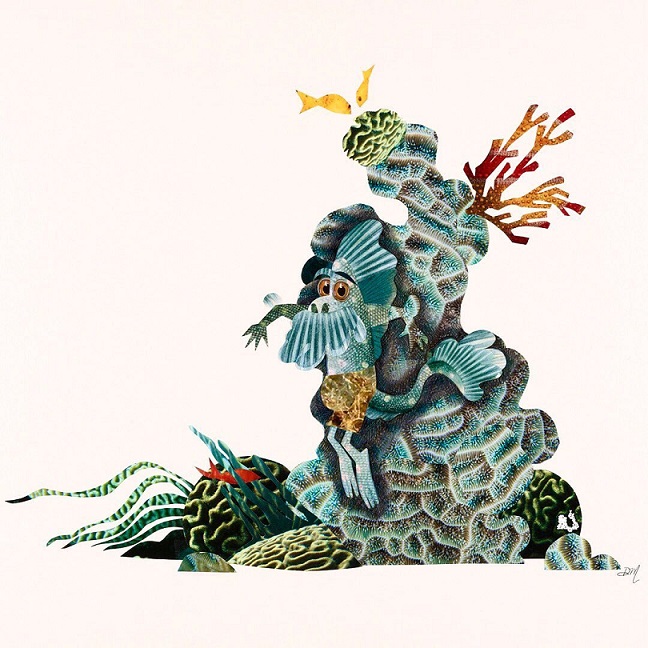
AV: These textures also seem a camouflage device for the sea monsters.
DM: That was one story point that we were considering. In the film, the sea monsters physically hide. There’s a scene where Luca swims into a cave and hides in shadow from a boat that he sees. Really, the idea of texture came from staying true to the sea monsters’ decorative origin. When I was looking at sea monsters throughout history, they were always used decoratively, again in the mosaics, the fountains, the frescos. So, when I was designing the sea monsters, I wanted to stay decorative and beautiful.
AV: Did you draw your inspiration from actual, real sea animals, too?
DM: We did do that kind of exploration early on. For some of it I was incorporating lobster parts, shrimp parts and dolphin parts, but what we ended up doing was finding our own way, our own language which was just based in fantasy, you know, with large crests and spines. For Daniela I did look at some dragon work. We tried to get something a little more aggressive in her design. She was always intended to be that way, even if you look at the earliest conceptual art for her. But for the most part, I think we found something unique for our film.
AV: Among all the sea monsters, Uncle Ugo is certainly the most original.
DM: Zio Ugo is Lorenzo’s twin brother, if you can believe it. But because he’s spent so much time in the deep, he’s been transformed, by the darkness, by the lack of oxygen, the lack of exercise… So, he really is just this blob with atrophied muscles. His organs don’t work very well anymore and he’s lost so much color and integrity in his skin that he’s now translucent. You see all of his organs, and he’s lost a lot of his sight. This character was conceptualized by an artist whose name is Dan Holland, and he’s just perfect for animation. We collaborated with two animators, Alli Sadegiani and Theresa Reyes, and what they brought to this character, I feel, is what makes him memorable: the eyes going in all different directions, the vibration you get on his facial fins, the way he moves his mouth shape… We put a lot of love and a lot of specificity into that character. And then, of course, he was voiced by Sacha Baron-Cohen, who did an incredible job. So, I feel he was just this magical combination of all the skills that created him.
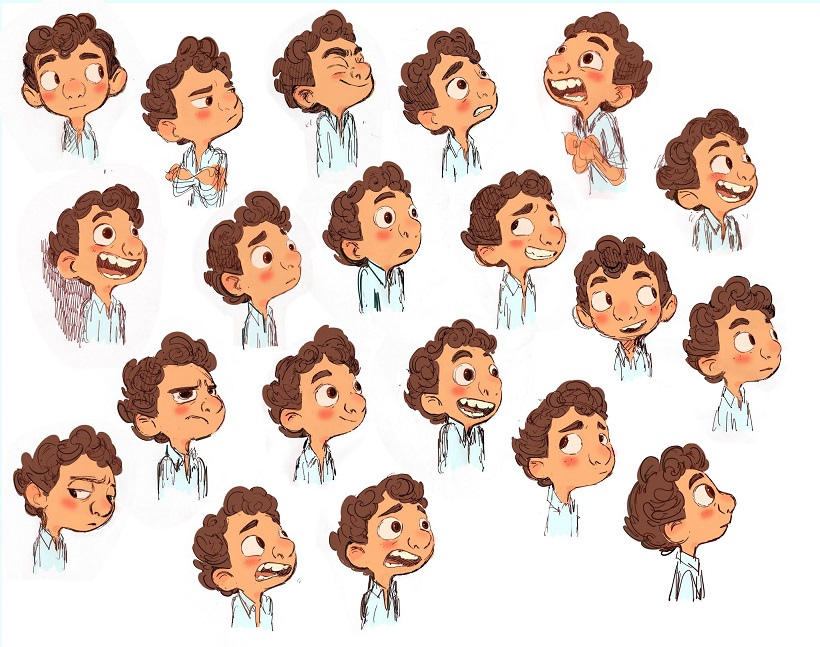
AV: How did you approach the human version of Luca?
DM: Luca was such a challenge as main characters always are. Because you want them to be specific, but this is also a character that’s going to take you through the film and we wanted the audience to be able to project themselves onto this character and experience his growth along with him. I would say the most challenging part of Luca’s design was finding the balance of the features and the shapes. There’s a lot of nuance with him as both sea monster and human. They are all deceptively simple. If you strip them down to just shape, you would think, ‘Oh, that doesn’t look so difficult, really!’ Seems simple. But honestly there’s so much nuance in the balance, placement and proportion the way he came together. There are details in this design that you may not notice by looking at them, but you feel them. For example, we have no straight lines anywhere in the character, no sharp corners. All of the joints are round, there’s no pinching or sharpness to the mouth. Everything is round and soft. There’s a ton of detail. So, I would say that was the most challenging aspect of designing Luca: finding nuance.
AV: And you have those big eyes, wide-open to the world…
DM: Of course. Luca is pure curiosity. It’s really his eyes that guide him. It’s this need to see everything that pushes him through the film to make these very important and complex decisions – to leave his family and run away. This is all done through his eyes because he’s seen things that are so beautiful and spark so much curiosity. He can’t help himself. And that’s why his eyes are the largest thing on his face and he has the largest eyes of any character in the film.
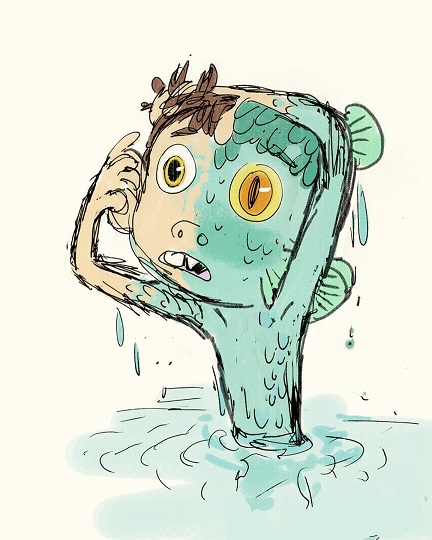
AV: How are the two versions of Luca and his fellow creatures – sea monster and human – connected together?
DM: It wasn’t linear. I kind of went back and forth. You had to. It was important that both versions of the character were similar proportionally, even if we didn’t need to have the exact same proportion. We didn’t want any growth or shrinking. We wanted the proportions to be about one to one. So, that was a good foundation for me. But more important than the two versions of the character looking exactly alike, it was more important that they felt like the same character. So, really, I was just going back and forth taking cues. Sea monster Luca has large eyes? Well, human Luca will also have large eyes. As I worked on the human, it helped me understand the sea monster and vice versa.
AV: All the characters of Luca are adorable, but which character do you feel the most related to?
DM: I would say Giulia. Love her! And like everything else of this film, she was a massive collaboration. We had beautiful ideas coming out of Story. She’s such a spitfire, so full of energy. We created her, but above all I am inspired by her! I want to be Giulia. That’s like my goal, because she’s a beautiful mixture of standing up for herself and standing up for others. She takes care of herself but she’s very quick to think about the people around her.
She was actually a redhead before I started designing her, which was serendipity. It’s something that Enrico pulled towards, and from there I just continued in putting more of myself into her because I related to her so much, and to the energy she brings to things. One very important aspect of her design is her nose. It’s a nose that you don’t find commonly on female characters in animation. It’s just a fact. We wanted to do something a little different with her. And then of course her outfit really makes her different from the rest of the kids in town. She’s got a fisherman’s cap, and her pants come from Massimo’s childhood. That’s why they’re so worn. It’s sentimental for her, because she’s proud of where she comes from. All these things combine to meet her character. And of course, you can’t forget the hair. We had brilliant artists who worked on it. A little bit like Massimo but, you know… red! She’s really a presence!

AV: How did you transfer all that beautiful art into modeling?
DM: Character Art Director is about designing the characters on paper and having a lot of fun doing the concepts, all the beautiful, whimsical, lyrical art that the visual development will create. But that’s just a short period, you know. It’s a beautiful little flash. The meat and potatoes of my job is actually technical art, working with the modelers, doing the technical drawings, shaping, massaging the characters. All of that work is not as glamorous to look at, but that’s the art, that really is the art. Because my job is to shepherd the characters through the pipeline. I had a wonderful time. The Lead Modeler – her name is Nancy Tsang – understood these characters. She understood the design language as much as I did. And with each modeler, what I’m doing is providing drawings. They respond by making adjustments to the model and send images back to me. Then I make drawings on those and send them back to them. Really, it’s a back-and-forth collaboration and communication. And I did this on all the characters, for all the characters, with all the modelers. I must have done I wanna say hundreds of draw-overs, but I would venture to say at this point maybe a thousand, maybe more. It’s a lot of work! But really, it’s you and the modeler massaging the character, me with my drawings, then with the computer. And you’re building the character together. And then, the animators come in.
AV: Indeed, on Luca, you were both Character Art Director and Animation Sketch Artist Lead. Can you tell me about that part of your work?
DM: It’s really a party at that point. Because the animators take the model and begin to move the character around and experiment. One animator says ‘well, in order to hit Deanna’s drawing, I need this control’. So, the modeler makes sure that they have that control. It’s really a three-department collaboration, and it’s really, really fun. That was the most fun I had, honestly, watching these characters come together three dimensionally – not just in the computer but because there were three departments working on that. They were coming together from three different directions. Then, I switched departments and moved into animation. Our animators are brilliant – I don’t need to say that, but they really are! And they’re doing a lot of experimentation to find the animation style of the film that is going to complement our characters, because these things have to be cohesive. So, at the beginning, I went to Animation and I said, ‘Look, Art has discovered these things about the characters. This is where the characters come from, this is why they look the way they do.’ Because Art makes a lot of deliberate choices and Animation needs to know these choices in order to do the best work. And that’s where animators come in. They just do this amazing work and I’m there to draw over the shots, if needed, to bring the characters on model, to make sure that they look their best and that they are the most appealing. I strengthen poses. Sometimes, I also collaborate with the animators on acting choices and physicality, but again, it’s just a really a big collaboration.

AV: What character was the most challenging or rewarding to work on?
DM:I think they were all rewarding. What’s interesting about our characters is, even though the design language is very cohesive and they all share the same language, we did have characters that were a little different, like Ercole for example. Ercole has a lot of large features, and because of that we had to work very hard at finding his best angles. He’s kind of like a Picasso painting. We would have to push and move things around, pull his nose out in silhouette, his lips out in silhouette when he would talk. We found a much more dynamic way for him to move because he’s so energetic and he is so in your face. So, Ercole was a different kind of challenge from the rest of the human characters. And with the sea monsters, we’d have the fins and the tails and there was a lyricism to the way that they had to move and flow. That required its own language.
AV: What is your favorite medium as a Character Designer?
DM: I’m a pen/paper kind of person. Very simple. I like a nice black pen, black ink, and I love animation paper because it has that translucency and I can easily see the drawing underneath if I wanna make a new one. And really just marker. Pretty simple. And if I’m not doing drawings like that, I’m collaging, sculpting or trying something completely different.
AV: Luca is a film about transformation. After working on it, do you feel yourself transformed?
DM: Yes! I think so! I could say that career-wise, academically, and as a person. Coming into the role, I thought I knew what it entailed. But it entailed so much more than what I thought. And I learned tremendously from everyone around me, just because I got to collaborate so much. So, in that regard, very transformed. And then, as a person, I think working on this film, with Enrico, again collaborating with so many people, I actually developed a lot more empathy, understanding. You have to be very flexible when you work with a lot of folks because everyone has their own way of working, their own way of approaching things. So, it’s important that I become very flexible to make sure that I meet them where they need me to be, and that I give them what they need so that they can do the best work. You’re in service to people.
With our thanks to Deanna Marsigliese and Chris Wiggum at Pixar.




